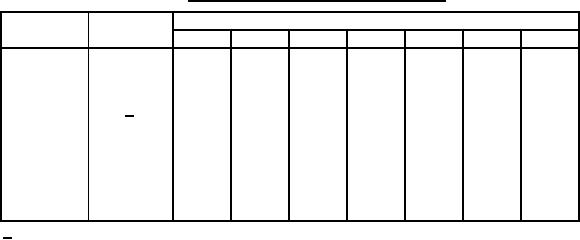
FED-STD-228A
3.1.2.1 Careful maintenance of die-cutting edges is of extreme importance and may be obtained by daily
light honing and touching up the cutting edges with jeweler's hard Arkansas honing stones. The condition
of the die may be judged by investigating the rupture point on any series of broken specimens. When
broken specimens are removed from the grips of the testing machine, it is advantageous to pile these
specimens and note if there is any tendency to break at or near the same portion of each specimen.
Rupture points consistently at the same place may indicate that the die is dull, nicked, or bent at that
particular position.
3.1.3 Cutting support. Rubber belting, leather belting, light cardboard, or other material with a smooth,
slightly yielding surface that will not injure the cutting edge of the die during the cutting or stamping of the
specimen.
Table I. Dimensions in inches for standard dies.
Dimension
Tolerance
Die
I
II
III
IV
V
VI
VII
A
± 1/32
1
1
1
5/8
5/8
5/8
5/8
B
Maximum
1½
1½
1½
1 1/8
1 1/8
1 1/8
1 1/8
C
Minimum
5½
5½
4½
4
5
5
4½
± ¼ 1/
D
1¼
1¼
1¼
1¼
1¼
1¼
1¼
± 1/32
D-E
½
½
½
½
½
½
½
± 1/16
F
1½
¾
¾
¾
1½
1½
¾
± 1/32
G
9/16
9/16
9/16
9/16
9/16
9/16
9/16
± 1/16
H
1
1
1
5/8
5/8
5/8
5/8
± 1/16
L
2 5/16 2 5/16 1 5/16 1 5/16 2 5/16 2 5/16 1 5/16
W
See figure 0.500 0.250 0.250 0.125 0.125 0.250 0.250
1/ For dies used in clicking machines, it is preferable that this tolerance be ± 1/64 inch.
4. PROCEDURE
4.1 Preparation of specimen.
4.1.1 Buffing. If the piece from which the specimen is to be prepared is too thick or has an uneven
surface that may interfere with the determination of thickness, the piece or portion of the piece shall be
buffed as described in method 3011. The specimen shall be permitted to rest at least 30 minutes
between buffing and testing. Specimens shall be buffed in the strip form before cutting with a die.
4.1.2 Dumbbell. Specimens of the required shape and size shall be cut or stamped from the piece of
material with the required die. To facilitate cutting, the edge of the die may be lubricated with water
containing a wetting agent and a corrosion inhibitor before each specimen is cut. The cut edges shall be
perpendicular to the other surfaces of the specimen, have a minimum of concavity, and be free from
ragged edges.
4.1.3 Straight specimen. A specimen of proper length for clamping in the grips of the testing machine
shall be cut from the unit or piece to be tested. The specimen shall be free from nicks. If possible, the
specimen should be cut with a die or with a single stroke of the cutting tool.
92
For Parts Inquires call Parts Hangar, Inc (727) 493-0744
© Copyright 2015 Integrated Publishing, Inc.
A Service Disabled Veteran Owned Small Business